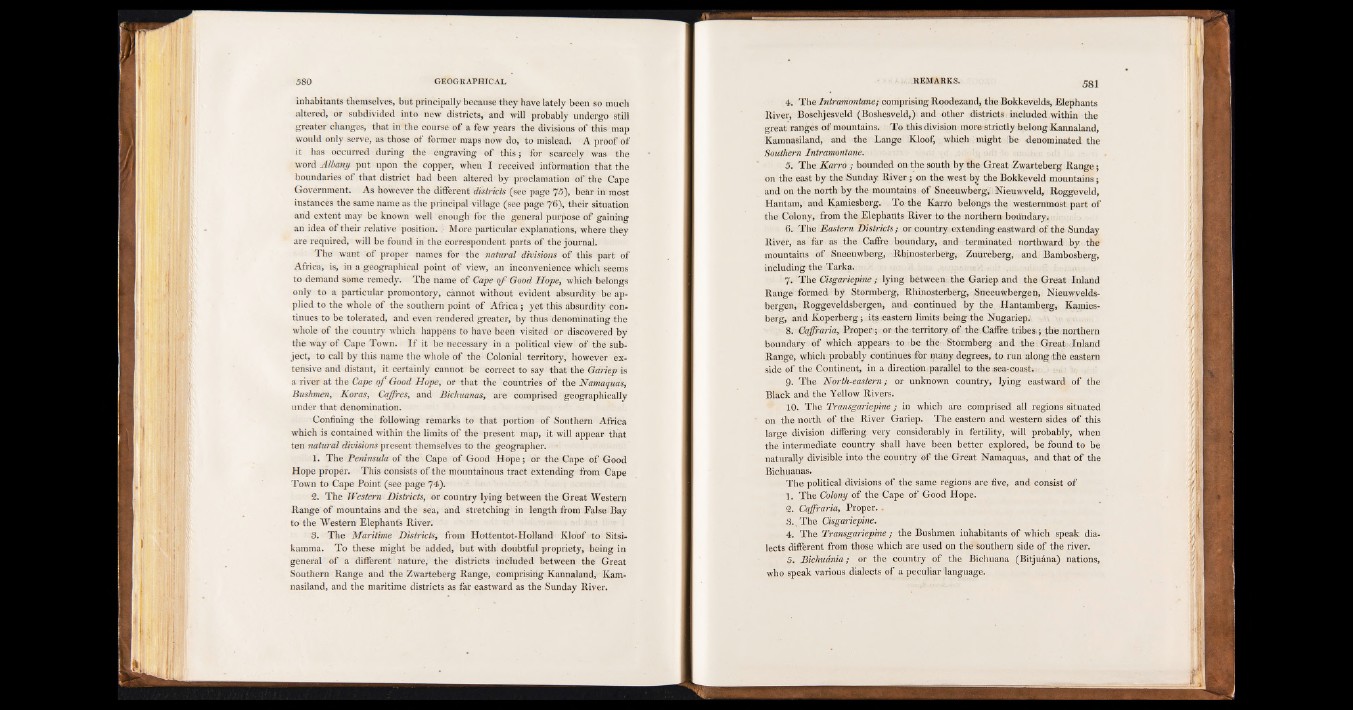
inhabitants themselves, but principally because they have lately been so much
altered, or subdivided into new districts, and will probably undergo still
greater changes, that in the course of a few years the divisions of this map
would only serve, as those of former maps now do, to mislead. A proof of
it has occurred during the engraving of this; for scarcely was the
word Albany put upon the copper, when I received information that the
boundaries of that district had been altered by proclamation of the Cape
Government. As however the different districts (see page 75), bear in most
instances the same name as the principal village (see page 76), their situation
and extent may be known well enough for the general purpose of gaining
an idea of their relative position. • More particular explanations, where they
are required, will be found in the correspondent parts of the journal.
The want of proper names for the natural divisions of this part of
Africa, is, in a geographical point of view, an inconvenience which seems
to demand some remedy. The name of Cape o f Good Hope, which belongs
only to a particular promontory, cannot without evident absurdity be applied
to the whole of the southern point of Africa ; yet this absurdity continues
to be tolerated, and even rendered greater, by thus denominating the
whole of the country which, happens to have been visited 01* discovered by
the way of Cape Town. If it be necessary in a political view of the subject,
to call by this name the whole of the Colonial territory, however extensive
and distant, it certainly cannot be correct to say that the Gariep is
a river at the Cape o f Good Hope, or that the countries of the Namaquas,
Bushmen, Koras, CaffreSy and BicJmanas, are comprised geographically
under that denomination.
Confining the following remarks to that portion of Southern Africa
which is contained within the limits of the present map, it will appear that
ten natural divisions present themselves to the geographer.
1. The Peninsula of the Cape of Good Hope; or the Cape of Good
Hope proper. This consists of the mountainous tract extending from Cape
Town to Cape Point (see page 74).
2. The Western Districts, or country lying between the Great Western
Range of mountains and the sea, and stretching in length from False Bay
to the Western Elephants River.
8. The Maritime Districts, from Hottentot-Holland Kloof to Sitsi-
kamma. To these might be added, but with doubtful propriety, being in
general of a different nature, the districts included between the Great
Southern Range and the Zwarteberg Range, comprising Kannaland, Kam-
nasiland, and the maritime districts as far eastward as the Sunday River.
4. The Intramontane; comprising Roodezand, the Bokkevelds, Elephants
River, Boschjesveld (Boshesveld,) and other districts included within the
great ranges of mountains. To this division more strictly belong Kannaland,
Kamnasiland, and the Lange Kloof, which might be denominated the
Southern Intramontane.
5. The Karro ; bounded on the south by the Great Zwarteberg Range;
on the east by the Sunday River; on the west by the Bokkeveld mountains;
and on the north by the mountains of Sneeuwberg, Nieuwveld, Roggeveld,
Hantam, and Kamiesberg. To the Karfo belongs the westernmost part of
the Colony, from the Elephants River to the northern boundary.
6. The Eastern Districts; 01* country extending eastward of the Sunday
River, as far as the Caffre boundary, and terminated northward by the
mountains of Sneeuwberg, Rhjnosterberg, Zuureberg, and Bambosberg,
including the Tarka.
7. The Cisgariepine; lying between the Gariep and the Great Inland
Range formed by Stormberg, Rhinosterberg, Sneeuwbergen, Nieuwvelds-
bergen, Roggeveldsbergen, and continued by the Hantamberg, Kamiesberg,
and Koperberg; its eastern limits being the Nugariep.
8. Cqffraria, Proper ; or the territory of the Cafffe tribes ; the northern
boundary of which appears to be the Stormberg and the Great Inland
Range, which probably continues for many degrees, to run along ¡the eastern
side of the Continent, in a direction parallel to the sea-coast.
9. The North-eastern; or unknown country, lying eastward of the
Black and the Yellow Rivers.
10. The Transgariepine ; in which are comprised all regions situated
on the north of the River Gariep. The eastern and western sides of this
large division differing very considerably in fertility, will probably, when
the intermediate country shall have been better explored, be found to be
naturally divisible into the country of the Great Namaquas, and that of the
Bichuanas.
The political divisions of the same regions are five, and consist of
1. The Colony of the Cape of Good Hope.
% Cqffraria, Proper..
8. The Cisgariepine.
4. The Transgariepine ; the Bushmen inhabitants of which speak dialects
different from those which are used on the southern side of the river.
5. Bichudnia; or the country of the Bichuana (Bitjuana) nations,
who speak various dialects of a peculiar language.